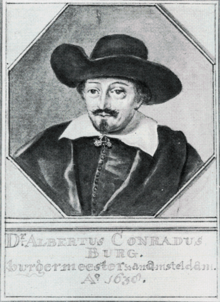Albert Burgh

Albert Coenraadsz. Burgh (1593 – 24 December 1647) was a Dutch physician who was mayor of Amsterdam and a councillor in the Admiralty of Amsterdam.
Biography
Burgh was born into a rich brewer's family. He studied medicine in
Around 1624 Burgh became one of the managers of the
At the solemn entry of Maria de Medici into Amsterdam in 1638, he and the burgomaster and regents, Andries Bicker, Pieter Hasselaer, Antonie Oetgens van Waveren and Abraham Boom welcomed her in the name of the city's government. Burgh offered De Medici a meal with rice, in those days very exotic and hardly known to Europeans. He sold her a famous silver rosary, captured in 1629 by Piet Hein in Brazil. In 1644 he became a manager of the Admiralty of Amsterdam.
During his lifetime he visited
Offspring
One of Albert Burgh's grandsons, also named Albert Burgh, was a
References
- ^ Biography of Jacob Dircksz de Graeff at Nieuw Nederlandsch biografisch woordenboek. Deel 2 (1912), by P.J. Blok and P.C. Molhuysen
- ^ Province of East New Jersey, 1609-1702: Princeton History of New Jersey by John E. Pomfret
- ^ The Empire State: A History of New York, edited by Milton M. Klein
- ^ Het kasteel van Elmina: in het spoor van de Nederlandse slavenhandel in Afrika door Marcel van Engelen (2013)
Sources
- Elias, J.E.(1903–1905, reprint 1963) De vroedschap van Amsterdam 1578-1795, two volumes.
- KNAW
